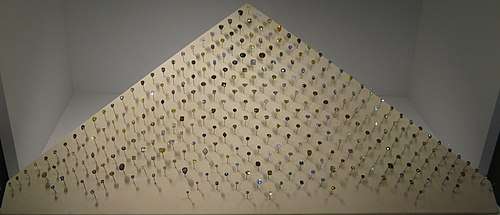Aurora Pyramid of Hope
The Aurora Pyramid of Hope is a collection of 296 natural diamonds in a wide variety of colors, billed as "the most comprehensive natural color diamond collection in the world".[1] It is owned by Aurora Gems, Inc., a diamond merchant specialising in fancy color diamonds. The collection has been displayed on loan in a pyramid-shaped display case in various major museums since 1998. Aurora Gems was founded by Harry Rodman (1909–2008) a gold refiner from the Bronx, and Alan Bronstein, a diamond dealer from New Jersey, who began collecting colored diamonds in 1979. After Rodman's death, ownership of the collection became the subject of a dispute between Bronstein and Rodman's heirs, including Rodman's wife, who was also Bronstein's mother.[2]


The original 260-gem collection was on public display at the American Museum of Natural History in New York City from 1989 to 2005 in the Morgan Hall of Gems. It was the centerpiece for the museum's 1998 exhibition The Nature of Diamonds which toured Japan, Canada and the U.S. In 2005 the collection moved to the Natural History Museum of London.[3] At that time 36 new specimens were added to the original 260 diamonds, for a total weight of 267.45 carats (53.490 g).
Notes
- "Aurora Collection on Display at London's Natural History Museum". News Releases. GIA. Archived from the original on 23 November 2008.
- Cohen, Patricia (30 March 2012). "2 Families Tangle Over Diamonds". New York Times. Retrieved 17 June 2013.
- "Diamonds at the Museum". Natural History Museum. Retrieved 17 June 2013.
External links
- Aurora Pyramid of Hope Aurora Gems, Inc.